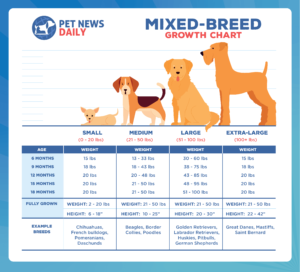Though every mixed-breed dog is different, some general guidelines can help you track your puppy’s growth. We consulted with our veterinarian, Dr. Jennifer Coates, who reviewed and approved data about mixed-breed weights and sizes, which we then used to create a convenient mixed-breed dog growth chart.
The chart shows you a mixed-breed puppy’s monthly average weight range during the growing phase. You can also refer to the puppy weight calculator to get an idea of how big your puppy is likely to get.
In This Article
Mixed-Breed Growth Chart
Fully Grown: 21-50 pounds, Height 22-42 inches
Text Transcript of the Mixed Breed Growth Chart
| Mixed Breed Age | Small Dog (0-20 Pounds) Chihuahuas, French bulldogs, Pomeranians, Daschunds | Medium Dog (21-50 Pounds) Beagles, Border Collies, Poodles |
Large Dog (51-100 Pounds) Golden Retrievers, Labrador Retrievers, Huskies, Pitbulls, German Shepherds |
Extra Large Dog (100+ Pounds) Great Danes, Mastiffs, Saint Bernard |
|---|---|---|---|---|
| 6 months old 9 months old 12 months old 15 months old 18 months old |
15 lbs 18 lbs 20 lbs 20 lbs 20 lbs Fully Grown: 2-20 pounds, Height 6-18 inches |
13-33 pounds 18-43 pounds 20-48 pounds 21-50 pounds 21-50 pounds Fully Grown: 21-50 pounds, Height 10-25 inches |
30-60 pounds 38-75 pounds 43-85 pounds 48-95 pounds 51-100 pounds Fully Grown: 21-50 pounds, Height 20-30 inches |
15 pounds 18 pounds 20 pounds 20 pounds 20 pounds Fully Grown: 21-50 pounds, Height 22-42 inches |
About Mixed Breeds
You know your new puppy isn’t a purebred. A purebred dog comes from parents of the same breed that are typically registered with the American Kennel Club (AKC) and conform to certain breed standards. A true purebred dog will have a pedigree that traces back to its ancestors.
A dog that isn’t purebred is typically considered to be a mixed breed dog. The term indicates nothing about the quality of the dog—only that the dog’s parents weren’t registered and both parents weren’t of the same breed. Mixed breed dogs have no pedigree and usually aren’t registered, though some mixed-breed registries will offer documentation.
The AKC Canine Partners Program, for instance, welcomes all mixed-breed dogs of any age to the AKC family. If you enroll your mixed-breed pup in the program, you can then enter your dog in AKC sports and events, like Agility, AKC Rally, Obedience, and more.1
Some mixed breed dogs are called “designer dogs” because the breeders intentionally mixed the breeds. Sometimes called a “hybrid dog,” these dogs are the result of combining existing breeds to form a new one. An example is the Labradoodle, which is a combination of the Poodle and the Labrador.
A rarer type of hybrid dog is the result of breeding a dog with a wild animal like a wolf or coyote. Sometimes these are intentional pairings made by breeders, while other times they are accidental. These animals aren’t usually recommended as pets because they can retain their wild-animal traits.
Basic Stages of Mixed Breed Dog Growth
Mixed breed dogs can vary greatly in size, but you can count on some basic stages of puppy growth. Keep in mind that your puppy’s breed types, sex (male or female), birth weight, diet, and exercise will all play a role in her final adult weight.2
If you know your mixed-breed dog’s heritage—which two breeds she comes from—you can check the AKC’s breed weight chart and compare the two breeds to get a general idea of how big your puppy will get.
Use the mixed-breed growth chart only to determine a general estimate. Dogs pass through development stages at different rates. There are differences between breeds, but also between individuals of each breed. Talk to your veterinarian if you have any questions about how your puppy is doing.
The most rapid growth in most dogs, including mixed-breed dogs, occurs within the first few weeks. From birth to eight weeks old, your pup will grow faster than at any other point in her life.
After that, puppies will experience the fastest growth rate in their first six months.3 Your dog will likely reach about 60 percent of her adult height by the time she’s four months old.
You may notice additional growth spurts at any time after that up to a year old. Small-breed dogs will achieve their adult height and weight faster than medium- or large-breed dogs. Most dogs will become fully grown in 12-18 months, though large breeds can take up to two years or more.
As your mixed-breed puppy grows, make sure he has the nutrition needed for growth without going overboard. Overweight and obesity in puppies can lead to health problems later in life. A good rule of thumb is to feed puppy-specific foods until your pup reaches full growth, which is usually around 11-14 months of age.
How Big Do Mixed Breed Dogs Get?
When estimating how big your mixed-breed dog will get, start with his ancestry if you can. If you know the puppy’s parents and what breed(s) they were, you can get a general idea of how big your dog will get.
The larger the breeds of your dog’s parents, for instance, the larger your dog is likely to be as an adult, and vice versa. Some mixed breeds take after one breed in their background more than the other, however. In that case, examine your dog’s physical characteristics. Check the muzzle, tail, ears, coat, and body type. Then compare your dog to the breeds in his background.
Once you find the breed that your dog seems to be most like, you can use that breed’s weight chart to get an estimate of how big your dog will get.
You may have heard that you can examine your puppy’s paw size and estimate his adult weight from that. This works for many breeds. Some breeds, however—like Bulldogs—naturally have big paws for their size, while others—like Collies—naturally have small paws for their size. So keep that in mind as you’re checking your dog.
Consider too your dog’s gender. As with many other animals, males are typically larger than females.4
If you’re not sure which breed your pup is or if you know they’re a mix of several, you can try this simple formula:5
(Current weight/Age in weeks) x 52.
For example, if your pup is 25 pounds at 16 weeks of age, the formula would look like this:
- (25/16) = 1.57 (rounded up)
- 1.57 x 52 = 82 pounds (rounded up) adult size
This is only a starting point, though. Your puppy’s weight may vary. The best time to use the formula is when your pup is between 12 weeks (for small breeds) and 20 weeks (for large breeds).
How Tall Do Mixed-Breed Dogs Get?
Though veterinarians often measure a dog’s weight, they don’t measure height as often. As a result, we have an absence of data to accurately determine the stages of height as your puppy advances into adulthood.
The American Kennel Association (AKA) does have height charts for each breed of dog. If you know the breeds in your dog’s background, you can use these charts to get a general idea if you have a mixed-breed dog.6
You can also measure your dog’s height at six months of age and estimate their final adult height (and weight) that way. Follow these guidelines:
- Small dogs (up to 20 pounds): At six months, these dogs are 75 percent grown.
- Medium dogs (21-50 pounds): At six months, these dogs are about 66 percent grown.
- Large dogs (51-100 pounds): At six months, these dogs are 60 percent grown.
- Extra-large dogs (>100 pounds): At six months, these dogs are only 50 percent grown.
When Do Mixed Breeds Stop Growing?
As mentioned above, smaller dogs reach their full size faster than larger dogs. A small dog will reach maturity between six and eight months. Larger dogs can take anywhere from 12 to 24 months, whereas giant breeds like the Great Dane can take up to two-to-three years.
As a general rule, small and medium puppies will finish growing at around half the age of their larger counterparts.7 Take a look at your dog’s bone structure, particularly in the legs. Longer, thicker bones indicate a larger dog. Short, thin legs more commonly belong to a smaller dog.
Things That Affect Growth
The proper diet is key if you want your mixed-breed dog to achieve optimal health and growth. Choose a balanced, nutritional puppy food, as a deficiency in any essential nutrient can compromise a dog’s health. Since puppy foods come in a variety of sizes (small breed, large breed), try to find out what breeds are in your pup’s background so you can make the right choice. If you’re not sure, ask your veterinarian.
Next, make sure your mixed-breed pup is getting the right number of calories. Underfeeding can compromise growth while overfeeding can lead to excessive weight gain. You can monitor your puppy’s weight and body condition score (the dog equivalent of body mass index or BMI), and then adjust your puppy’s food intake as needed.8
One way to see how your pup is doing in terms of growth is to check his ribs. If you can feel them but not see them, you’re probably in good shape. You should also be able to see the dog’s waist curve when you look at him from above. Giving your dog daily exercise will help him maintain a healthy weight.
If your dog is not gaining weight like you think he should check with your veterinarian. Some health issues like the following can affect the growth rate:
- Improper nutrition
- Over-feeding (overfeeding can cause joint problems and chronic diseases later in life)
- Worm infection (hookworms or roundworms)
- Spaying/neutering (this will not stunt growth, but can affect the joints of large-breed dogs—the recommendation is to wait until your female reaches her first heat cycle, and until your male is around two years old)
- Excessive running (when your dog is still growing, excessive impact from running can predispose them to joint issues later in life—more a problem with large-breed dogs; wait until 15 months to allow bones to grow properly)
Mixed Breed Weight Calculator
PUPPY WEIGHT CALCULATOR
Frequently Asked Questions
To estimate your mixed-breed puppy’s adult weight, use our puppy weight calculator above. Or try this formula when your pup is between 12 and 20 weeks to get a general idea.
(Current weight/Age in weeks) x 52.
Your dog’s parents and gender also play a role in how big he will get. Use this information to estimate your dog’s final size.
A mixed-breed dog will grow at a similar rate to other dogs his size. A small dog, for instance, even though he is small, will grow at a similar rate to a purebred small dog. That means that he’ll grow quickly, reaching near adult size at four months old. Medium-sized dogs will grow quickly until about 4-6 months, after which growth will slow down. Large dogs will grow quickly until 6-8 months, then slow down after that, though they will continue to grow until 18 months to 2-3 years.
You may have heard that when puppies reach around five months of age, they can appear to be going backward. Usually, this refers to behavior rather than growth. Your puppy may have more accidents in the house than before, for example, or may ignore your commands more often.
This type of behavior is normal at this age. You can think of your five-month-old mixed-breed dog as a toddler testing the limits and discovering his place in the family pack.
Growth at this stage depends on the dog’s breed(s) and final size. Small dogs will be at about their full growth at 5 months, as will medium dogs. Large dogs will still be growing.
Again, this depends on the size of the dog. Most small dogs are considered about half their height and weight at around two-to-three months of age. Medium dogs reach that point around four months of age. Larger dogs take longer to grow. For them, their six-month weight is typically about one-half to two-thirds of their adult weight.
For an extra-large dog like a Great Dane, you can weigh him at six months, then double that to get a rough idea of how much he may weigh as an adult. Smaller dogs, however, will reach half their weight sooner than that.
A small dog can weigh twice as much at four months as he did at two months, for example. A medium-to-large breed may reach about two-thirds of his adult weight at six months old.
Additional Resources
If you’re looking for more information about dog growth in general, we’ve created a puppy weight calculator, an in-depth guide to how heavy your dog should be, and a series of growth charts for different breeds (and dogs and mixed breeds in general):
- Great Dane Growth Chart
- Goldendoodle Growth Chart
- Chihuahua Growth Chart
- Golden Retriever Growth Chart
- Labrador Growth Chart
- Dog Growth Chart
- Mixed Breed Growth Chart
- Rottweiler Growth Chart
- Pit Bull Growth Chart
- Australian Shepherd Growth Chart
- French Bulldog Growth Chart
- Great Pyrenees Growth Chart
- Standard Poodle Growth Chart
- Bernedoodle Growth Chart
- Husky Growth Chart
Article Sources
Pet News Daily uses only high-quality sources, including peer-reviewed studies, to support the facts within our articles. Read our editorial process to learn more about how we fact-check and keep our content accurate, reliable, and trustworthy.
- AKC canine partners — How to enroll a mixed breed. (n.d.). American Kennel Club. https://www.akc.org/register/information/canine-partners/
- Hawthorne, A. J., Booles, D., Nugent, P. A., Gettinby, G., & Wilkinson, J. (2004). Body-weight changes during growth in puppies of different breeds. The Journal of Nutrition, 134(8), 2027S-2030S. https://doi.org/10.1093/jn/134.8.2027s
- Staff, A. (2020, March 3). Proper puppy nutrition nourishes rapid growth & development. American Kennel Club. https://www.akc.org/expert-advice/health/proper-puppy-nutrition-nourishes-rapid-growth/
- Staff, A. (2017, May 11). Breed weight chart – American Kennel Club. American Kennel Club. https://www.akc.org/expert-advice/nutrition/breed-weight-chart/
- Puppy growth: What you need to know. (n.d.). Bond Vet. https://bondvet.com/b/puppy-growth
- Dog breeds – Types of dogs – American Kennel Club. (n.d.). American Kennel Club. https://www.akc.org/dog-breeds/
- Paretts, S. (2021, August 10). When does my puppy finish growing? How long do puppies grow? American Kennel Club. https://www.akc.org/expert-advice/health/when-does-my-puppy-finish-growing
- Body condition scores | VCA animal hospital. (n.d.). Vca. https://vcahospitals.com/know-your-pet/body-condition-scores


